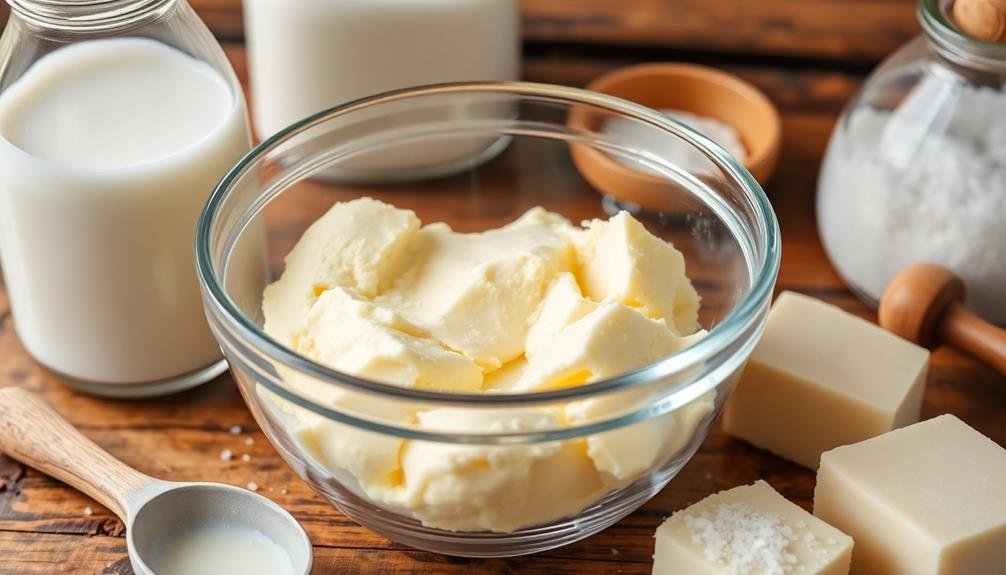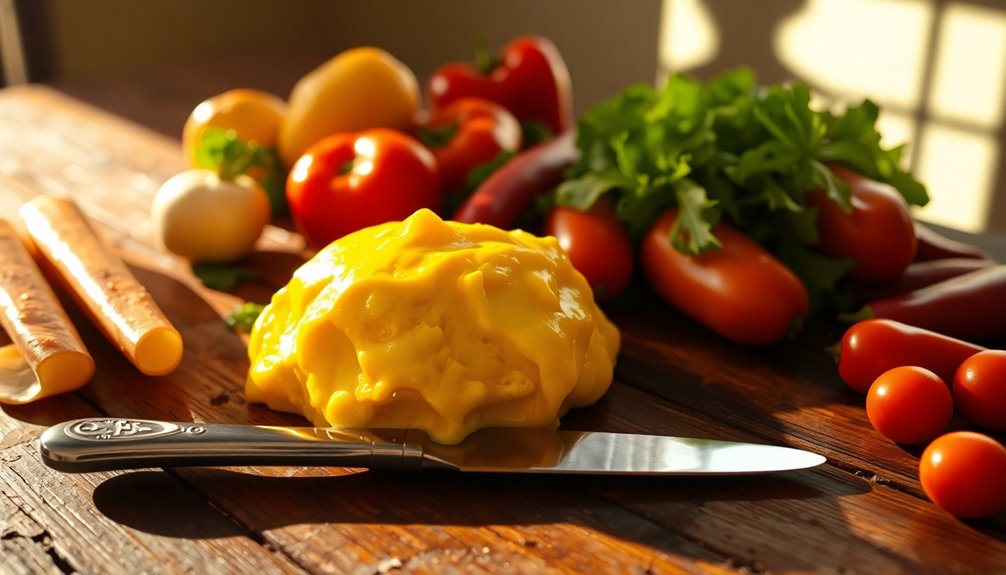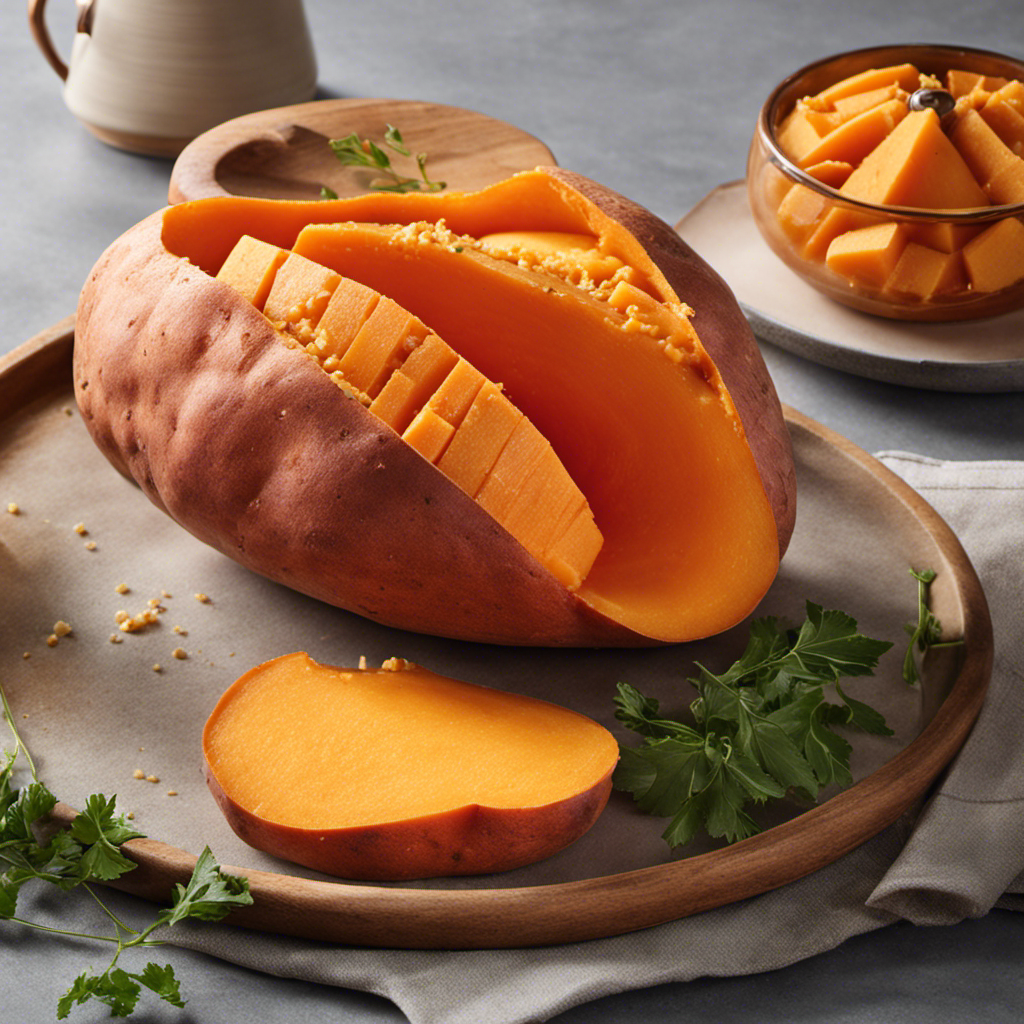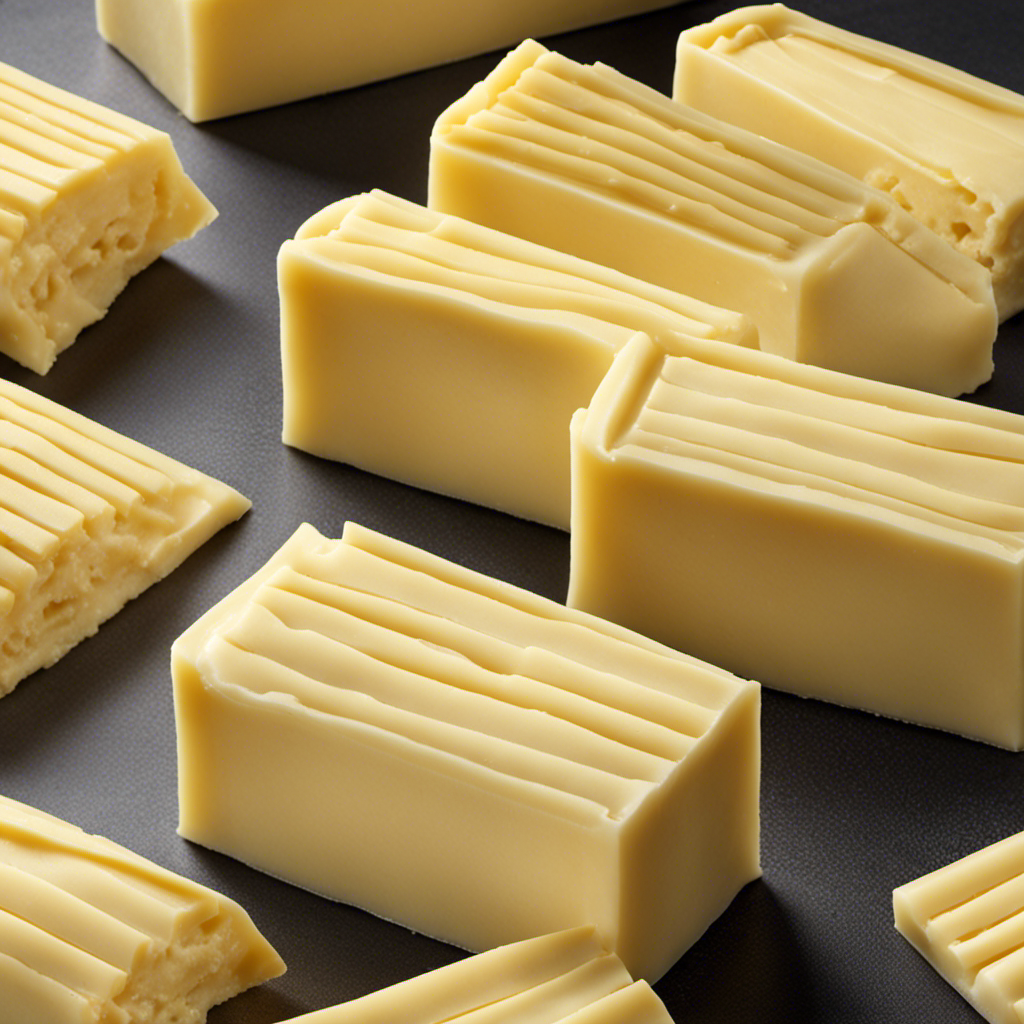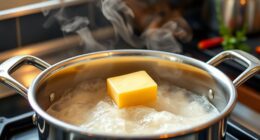To master butter making, you'll want to grasp some scientific principles that guarantee a rich, creamy product. Start with high-quality cream, ideally with at least 36% fat content. Temperature plays a key role in both the churning process and fat crystallization; aim for a range of 55°F to 60°F. Agitate properly to emulsify the fats and water, creating that silky texture. Adding cultures can enhance flavor through fermentation, providing unique taste nuances. Each step you take influences the final butter quality. Stick around, and you'll uncover more tips to perfect your butter-making technique.
Key Takeaways
- High-quality cream with 36%+ fat content is essential for creating rich, flavorful butter.
- Emulsification occurs through agitation, combining fat and water for a stable mixture.
- Maintaining an optimal churning temperature (55°F to 60°F) ensures smooth texture and effective fat distribution.
- Fermentation adds complexity and tang, enhancing flavor and extending shelf life through beneficial bacteria.
- Proper cooling post-churning locks in texture and flavor while preventing graininess in the final product.
Understanding Butter Ingredients
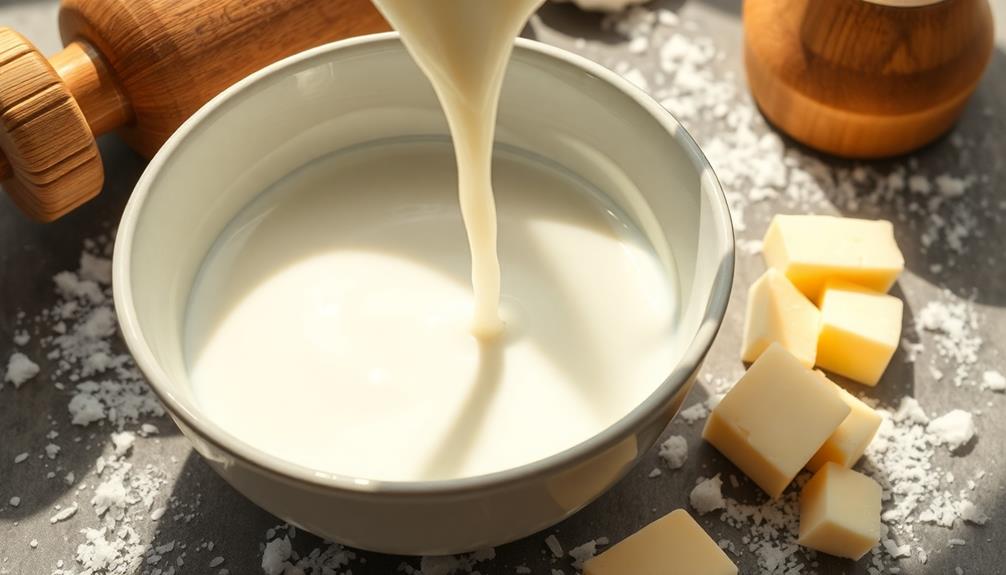
When you plunge into butter making, knowing the ingredients is vital for achieving the best flavor and texture. The primary ingredient is cream, but not just any cream will do. You'll want high-quality, fresh cream with a high-fat content, ideally around 36% or more. This fat content is essential, as it influences how well your butter will churn and how rich it will taste.
Next, consider salt if you're making salted butter. Salt enhances flavor and acts as a preservative, extending the butter's shelf life. You can experiment with different salts, like sea salt or Himalayan pink salt, to find your preferred taste.
Another ingredient to keep in mind is culture, which can be added for flavor and tang if you opt for cultured butter. This bacteria enhances the complexity of flavor, taking your butter to another level.
Lastly, don't overlook the role of temperature. Keeping your cream at the right temperature guarantees a smoother, more efficient churning process.
With these ingredients and considerations in mind, you're well on your way to crafting delicious butter that elevates any dish.
The Role of Cream
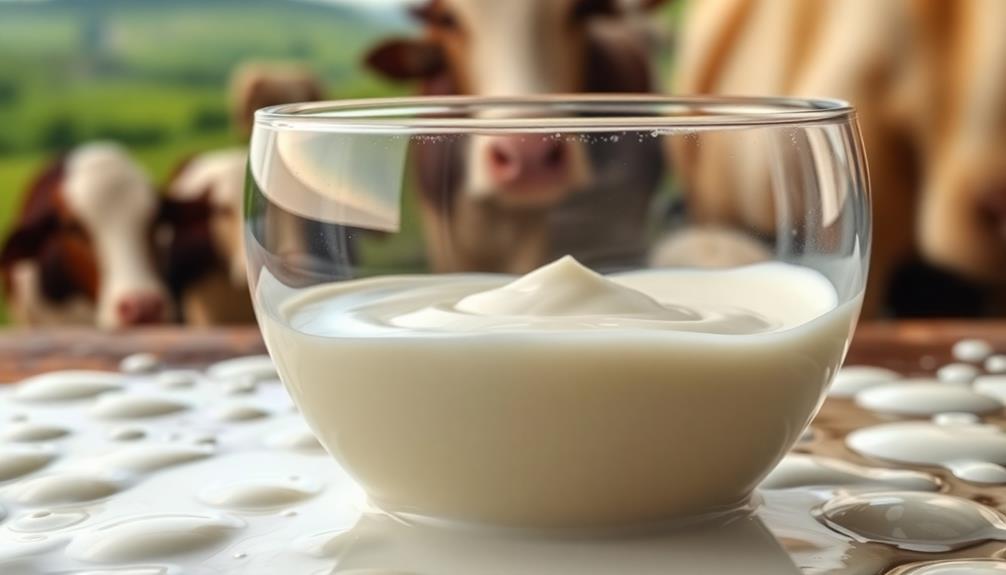
Cream plays a pivotal role in butter making, acting as the foundation for both flavor and texture. When you choose high-quality cream, you're setting the stage for a rich, creamy butter that can elevate your culinary creations.
The fat content in cream is essential; it determines how easily the butter will form and how well it will hold its structure. Selecting cream from top butter brands can further enhance the final product's quality and taste.
As you work with cream, keep in mind that its temperature greatly impacts the butter-making process. Warm cream emulsifies more quickly, leading to a smoother texture, while cold cream can result in grainy butter.
The composition of the cream also matters. Cream with a higher butterfat percentage yields a richer flavor and creamier texture, making it ideal for butter production.
Additionally, the presence of natural bacteria in fresh cream can enhance the flavor profile, giving your butter a unique taste.
Emulsification Process
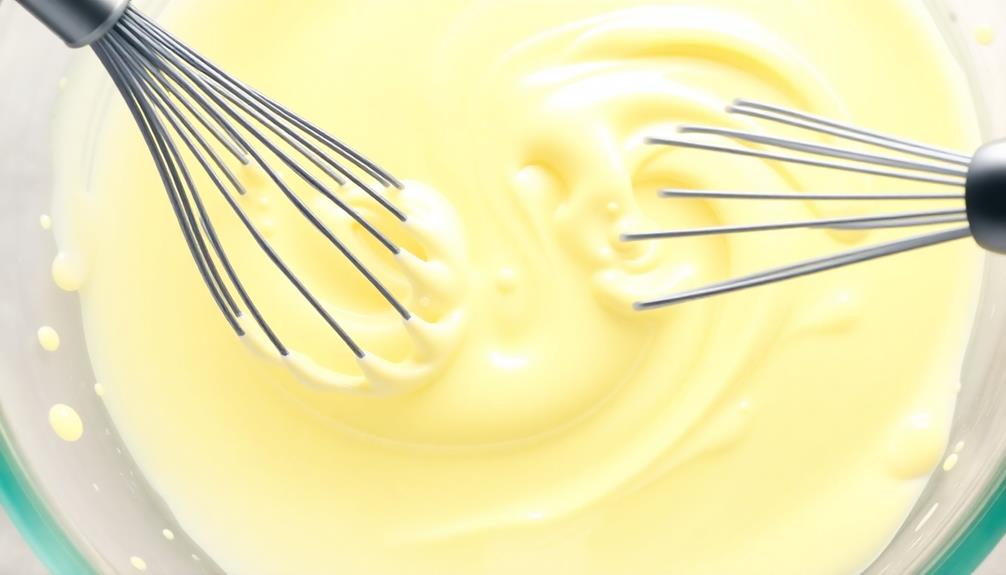
The emulsification process is fundamental in transforming cream into butter, as it involves breaking down the fat molecules and allowing them to combine with water. When you start with cream, the fat is dispersed in a liquid state.
Through emulsification, you create a stable mixture where fat globules are suspended in water, which is essential for achieving that creamy texture. During this process, you're fundamentally enabling the fat to aggregate and form clusters, which helps to trap water molecules within the structure.
This transformation is critical because it allows for the creation of a smooth and cohesive product. You'll notice that as you work with the cream, the change in texture indicates that emulsification is happening.
To guarantee proper emulsification, it's important to maintain the right temperature and incorporate the right amount of agitation, which prepares the fat for aggregation. The goal is to achieve a well-emulsified mixture that can hold together once you begin the next steps in butter making.
Agitation Techniques
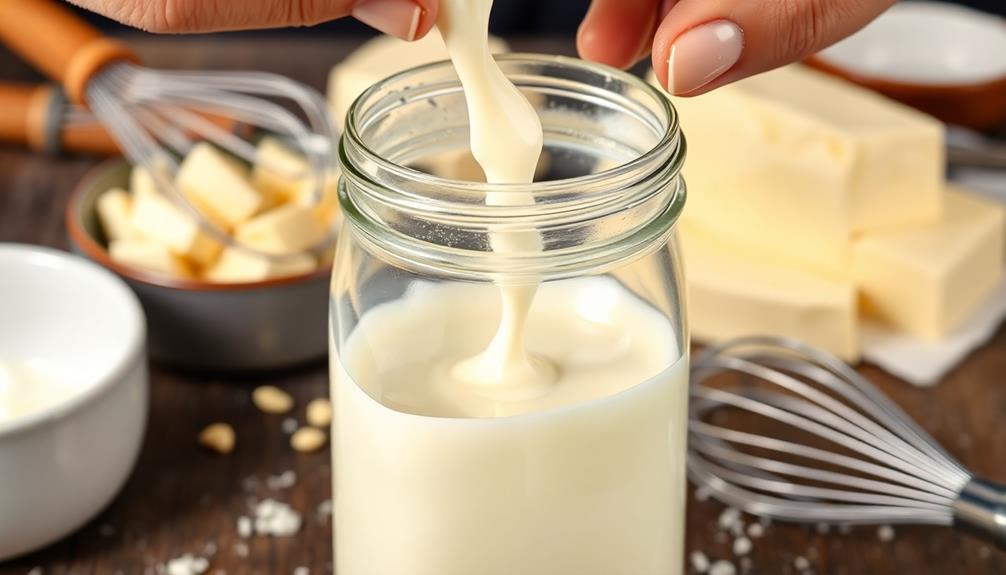
Achieving the right texture in butter making relies heavily on effective agitation techniques. You'll find that the way you agitate the cream can greatly influence the final product.
By using different methods and tools, you can create a smoother, creamier butter that's perfect for spreading or cooking.
Consider these agitation techniques to enhance your butter-making process:
- Whisking: This method introduces air, giving your butter a light texture. It's great for small batches.
- Blending: A blender or food processor can speed up the process, making it easier to achieve the desired consistency quickly.
- Churning: Traditional butter churns work wonders. The rhythmic motion encourages fat globules to clump together, forming butter effectively.
- Shaking: If you're feeling adventurous, try shaking cream in a jar. It's a fun, hands-on way to see the transformation from cream to butter.
No matter which method you choose, keep in mind that the key is to maintain a consistent motion.
This guarantees even distribution of fat, leading to that perfect creamy texture you're aiming for.
Happy butter making!
Fat Crystallization
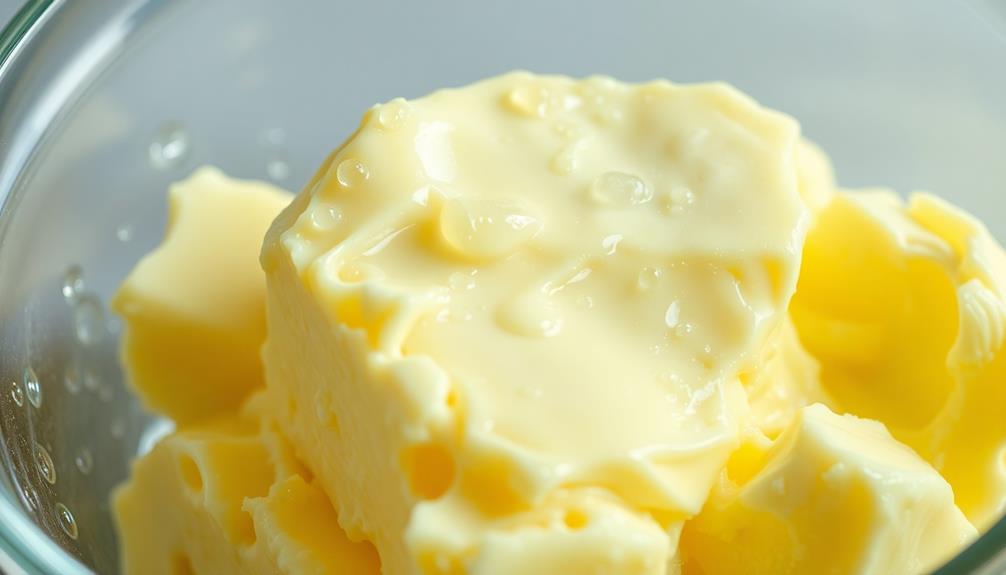
When you're making butter, understanding fat crystallization is essential. The temperature you maintain plays an important role in how fats solidify, and different types of fats behave in unique ways.
For instance, European butter, known for its higher fat content, can yield a creamier texture due to its specific fat crystallization properties.
Additionally, the use of various butter types can greatly affect the final product's mouthfeel and flavor.
Let's explore how these factors influence the texture and quality of your butter.
Role of Temperature
Temperature plays an essential role in fat crystallization during butter making, influencing the texture and consistency of the final product.
When you churn cream, you're creating a delicate balance of heat and cold. The temperature affects how fat molecules arrange themselves, determining whether your butter will be smooth or grainy.
To achieve the best results, consider these temperature aspects:
- Chilling the cream: Start with cream between 50°F and 60°F to promote fine crystal formation.
- Controlling the churn: As you churn, keep the temperature consistent to avoid uneven crystallization.
- Cooling the butter: After churning, quickly cool the butter to solidify fat crystals and lock in the texture.
- Storage temperature: Store your butter in a cool place to maintain its firmness and prevent unwanted melting.
Types of Fats
The type of fat you use greatly impacts the crystallization process during butter making. Fats can be classified into saturated and unsaturated categories. Saturated fats, like those found in dairy products, tend to crystallize more easily and provide a stable structure. This stability helps create a smooth texture in your butter.
On the other hand, unsaturated fats, such as those derived from vegetable oils, can lead to a less stable crystallization. They often produce a softer butter that may not hold its shape as well.
The melting point of the fats you choose also plays a significant role. For instance, higher melting point fats will solidify at lower temperatures, which can influence the final consistency of your butter.
When combining different types of fats, you can achieve a desirable balance. For example, mixing saturated fats with a small percentage of unsaturated fats can enhance the mouthfeel while maintaining stability.
Temperature Control
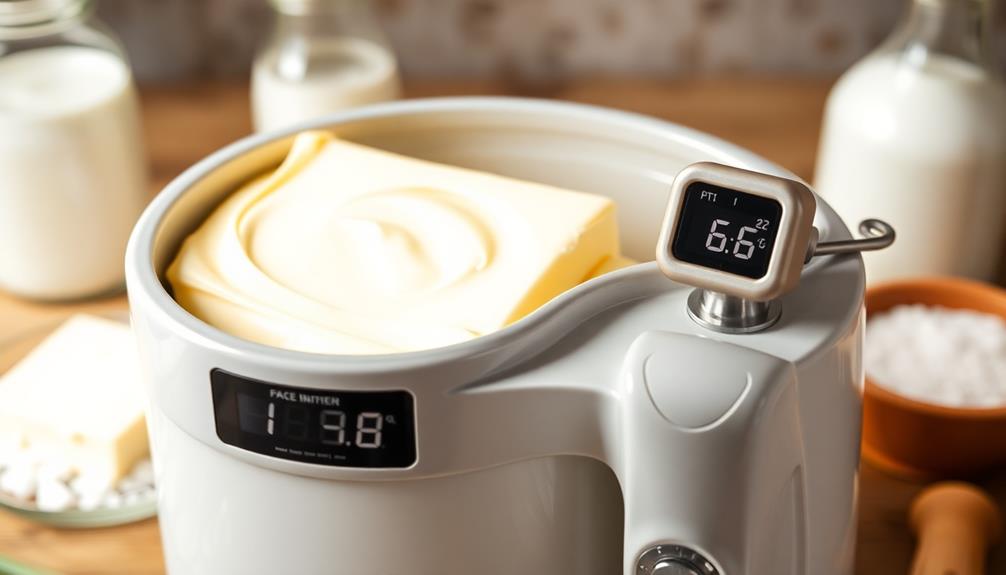
When making butter, controlling the temperature during churning is essential for achieving the right texture and flavor.
You'll need to pay close attention to the cooling process afterward, as it helps solidify the butter and lock in its freshness.
Optimal Churning Temperature
Achieving the right churning temperature is essential for successful butter making. When you're churning cream, the temperature directly influences the texture and flavor of your butter. Typically, the ideal churning temperature ranges from 55°F to 60°F (13°C to 16°C). At this temperature, the fat globules are pliable enough to break apart and coalesce into a smooth, creamy mass.
Here are some key points to take into account:
- Too Cold: If the cream's too cold, it'll be difficult to churn, leading to a grainy texture.
- Too Warm: If the cream's too warm, you risk over-emulsifying, resulting in a butter that's oily and less flavorful.
- Room Temperature: Letting the cream sit at room temperature for a short while can help achieve the ideal churning temperature.
- Consistent Monitoring: Use a thermometer to keep an eye on the temperature, ensuring you stay within the ideal range throughout the process.
Cooling Process Importance
Cooling the cream after churning is essential for developing the right texture and flavor in your butter. Once you've finished churning, the butter is still warm and soft, which can affect its final consistency. By cooling it promptly, you help the fat molecules solidify, resulting in a firmer butter that spreads easily.
Maintaining the right temperature during the cooling process is vital. If your butter cools too slowly, it can become grainy, losing that smooth, creamy mouthfeel you desire. On the other hand, if it cools too quickly, you might end up with a product that's too hard to work with. Ideally, you want to cool it to around 50°F (10°C) before you package or store it.
Additionally, cooling can enhance the flavor of your butter. As it cools, any residual moisture evaporates, concentrating the flavor profiles. This step is particularly important if you're adding salt or other flavorings.
Fermentation in Butter
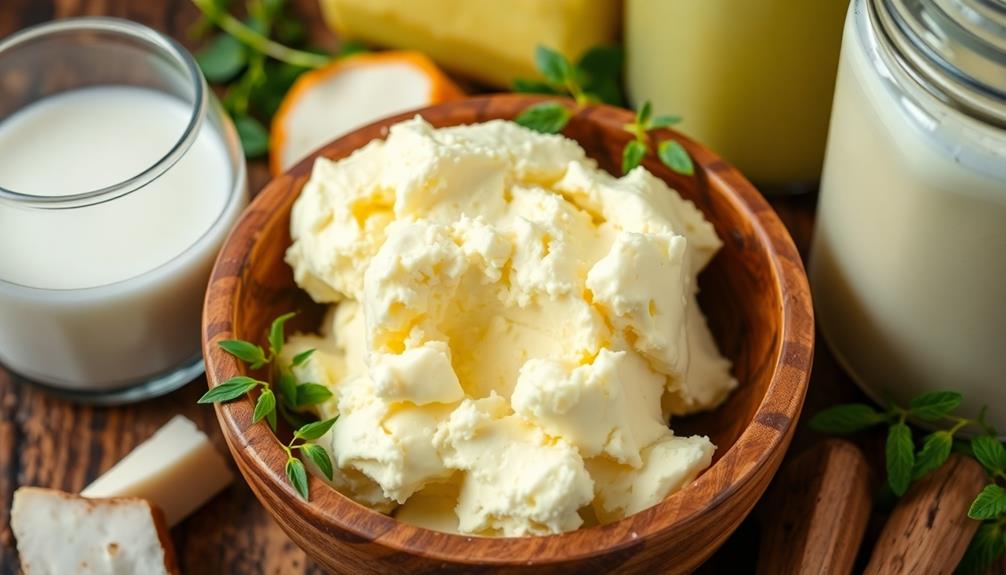
Fermentation in butter often plays an essential role in developing its distinctive flavor and texture. When you allow the cream to ferment, beneficial bacteria convert lactose into lactic acid, which not only enhances flavor but also affects the butter's consistency. This process creates a depth that you wouldn't achieve with unfermented cream.
Here's what you should know about fermentation in butter:
- Improved Flavor: Fermentation adds complexity, giving your butter a rich, tangy taste.
- Texture Alteration: It helps create a creamier texture, making it more spreadable.
- Extended Shelf Life: The acidic environment inhibits spoilage, allowing your butter to stay fresh longer.
- Nutritional Benefits: Fermented butter can have higher levels of vitamins and probiotics, contributing to your overall health.
When you choose to ferment your cream, you're not just making butter; you're crafting a product that reflects your care and attention.
Flavor Development
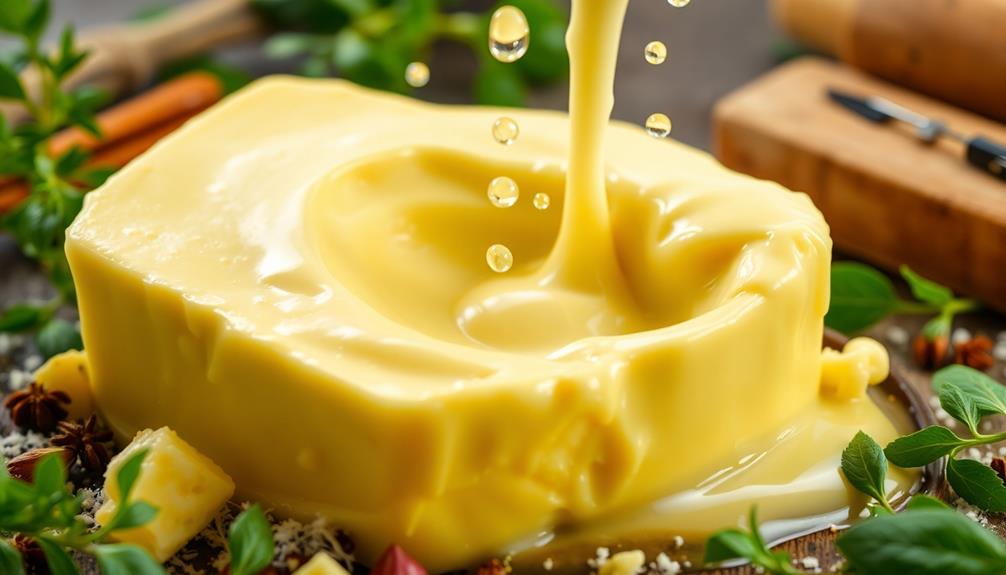
The process of fermentation sets the stage for the intricate flavor development in butter. During fermentation, lactic acid bacteria convert lactose into lactic acid, which not only lowers the pH but also creates a tangy flavor profile.
You'll notice that the choice of cultures considerably impacts the taste; different strains can produce varying flavor compounds, adding complexity to your butter. Additionally, savory flavor infusions using herbs can further enhance the overall taste experience.
As the milk fat breaks down during this process, volatile compounds, such as diacetyl and butyric acid, emerge, enhancing the buttery aroma and rich flavor. You might find that aging your cream before churning can intensify these flavors, allowing them to mature and develop further.
Don't forget that temperature plays an essential role too. Warmer conditions can speed up fermentation, leading to stronger flavors, while cooler temperatures can yield a milder taste.
You can experiment with these variables to find the perfect balance for your palate.
Frequently Asked Questions
What Is the Historical Significance of Butter in Various Cultures?
Butter's historical significance spans cultures, symbolizing wealth and hospitality. You'll find it in ancient rituals, traditional recipes, and as an essential ingredient in celebrations. It's shaped cuisines and social customs throughout time, reflecting cultural values.
Can Vegan Alternatives Replicate Butter's Properties in Cooking?
You know the saying, "Where there's a will, there's a way." Vegan alternatives can mimic butter's properties in cooking effectively, often providing creaminess and flavor, though they may lack some unique textures and melt qualities.
How Does Butter Production Differ Globally?
Butter production varies globally based on climate, cow breeds, and local traditions. In some regions, artisans craft small batches, while others utilize large-scale factories. You'll find unique flavors and textures influenced by these diverse practices.
What Are the Nutritional Differences Between Salted and Unsalted Butter?
When you're baking cookies, you might wonder if salted or unsalted butter affects taste. Nutritionally, salted butter contains added sodium, while unsalted offers more control over salt levels in your recipes. Choose wisely!
How Does Butter Impact Baking Outcomes Compared to Margarine?
When you bake, butter adds richness and flavor, while margarine often lacks that depth. Butter creates a flakier texture, enhancing pastries, whereas margarine can result in denser baked goods. Choose wisely for your recipes!
Conclusion
In butter making, you've learned how essential each ingredient and process is to achieve that creamy delight. Remember, "you reap what you sow"—the care you put into selecting quality cream and controlling the temperature pays off in flavor and texture. By mastering emulsification, agitation, and fermentation, you can create a delicious product that elevates any dish. So, get ready to whip up some tasty butter and impress your friends with your newfound skills!
